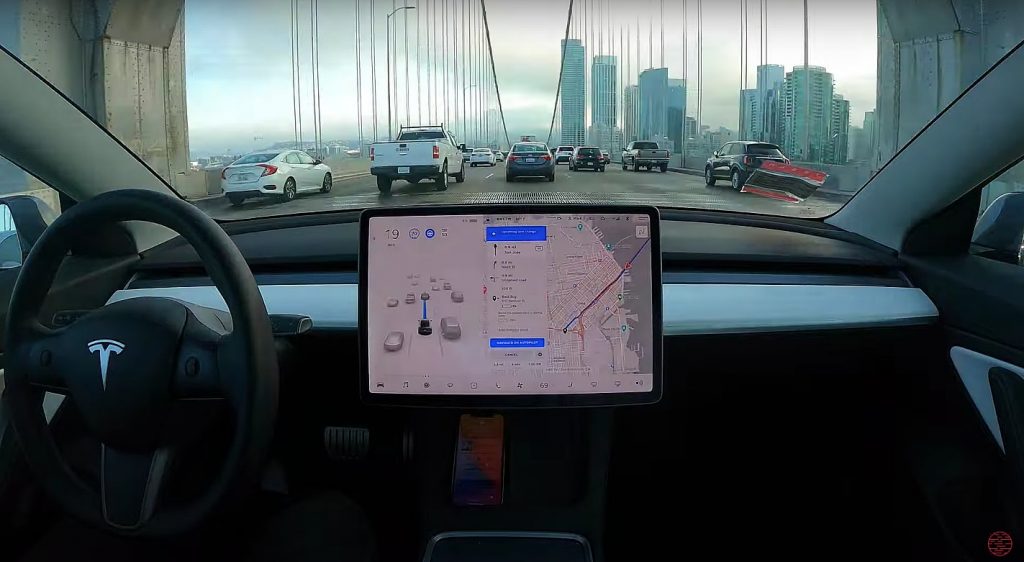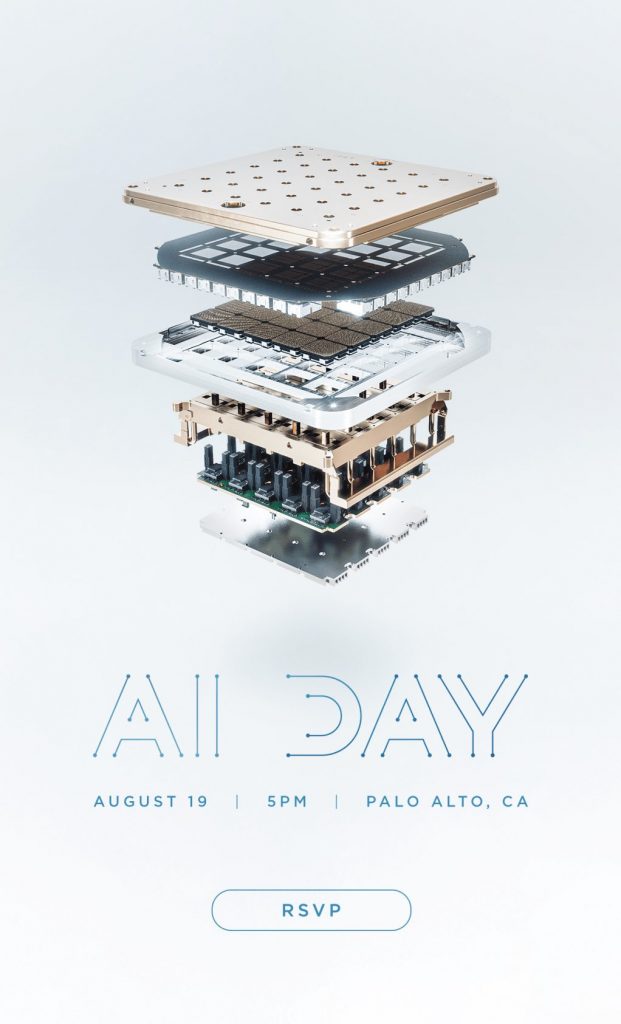Tesla’s AI Day is tomorrow, and the company has been largely silent about details of the upcoming event. Considering how artificial intelligence plays into Tesla’s energy and electric vehicle business, it is no surprise that there is some excitement for AI Day. With this in mind, here are some things that Tesla watchers could expect for the highly-anticipated event.
Updates from Autonomy Day
Tesla bull and Loup Ventures Managing Partner Gene Munster previously noted that AI Day would likely be a “second edition” of sorts for the company’s Autonomy Day event back in 2019. The invitations that have been sent for AI Day suggest that the company is looking to expand its AI use to more than just vehicles. This is something that Elon Musk has mentioned in the past.
During the Q1 2021 earnings call, Musk stated that in the long run, people would start perceiving Tesla as an “AI robotics company” instead of a carmaker or battery storage producer. “I think long term, people will think of Tesla as much as an AI robotics company as we are a car company or an energy company. I think we are developing one of the strongest hardware and software AI teams in the world,” Musk said.
If AI Day does become a follow-up to Autonomy Day, however, Tesla would likely have to discuss some of the updates it has rolled out to its vehicles and self-driving efforts since 2019. These include the removal of radar for the Model 3 and Model Y, which Musk expects would ultimately accelerate the company’s progress towards autonomous driving.

Project Dojo Details
Tesla’s Dojo Supercomputer has long been teased, but its specs and capabilities have never really been revealed by the company. AI Day would be a great venue to formally introduce the world to its supercomputer and its capabilities. Dojo is crucial to Tesla’s self-driving efforts as the computer is tasked with training neural networks that would, in turn, enable the company’s vehicles to behave even more like cautious and confident human drivers on the road.
Gene Munster noted that based on Elon Musk’s previous comments, it appears that Tesla has plans to make Dojo available to other automakers in the future. This should help not just Tesla but the entire auto industry transition into the self-driving era. Musk definitely seems optimistic about Dojo’s contribution to Tesla’s self-driving efforts, which have been both highly praised and criticized to date.
“Dojo is really a — it is a supercomputer optimized for neural net training. We think Dojo will be, probably in order of magnitude, more efficient on, say — not sure what the exact right metric is, but say, per frame of video, we think it will be an order of magnitude more cost efficient in hardware and in energy usage for a frame of video compared to a GPU-based solution or compared to the next best solution that we’re aware of. So then possibly that could be used by others,” Musk stated.

Beyond Automotive and Energy
Tesla already uses AI on its electric vehicles, and the company’s products like Autobidder show that artificial intelligence could also be invaluable for the energy sector. Interestingly enough, Tesla seems to be intent on expanding beyond these markets, with the company teasing more AI-based efforts in its formal invitation.
“This invite-only event will feature a keynote by Elon, hardware and software demos from Tesla engineers, test rides in Model S Plaid, and more. Attendees will be among the first to see our latest developments in supercomputing and neural network training. They’ll also get an inside look at what’s next for AI at Tesla beyond our vehicle fleet,” Tesla wrote.
Elon Musk has hinted at other “smart” products in the past. During his first appearance at the Joe Rogan Experience podcast in 2018, Musk has stated that it would be great to develop a “Tesla Smart Home” that includes an efficient HVAC system. Musk mentioned this once more in March 2020, when he noted that creating smart and energy-efficient home products would be great since Tesla is already developing a lot of the needed tech for its vehicles.
TSLA Volatility
Tesla watchers and investors would likely have to get ready for some volatility after AI Day tomorrow. While Tesla’s dedicated events such as Autonomy Day and Battery Day were filled to the brim with information, and while both events were mainly for recruitment, TSLA stock ended up dipping the day after. The day after Battery Day in September 2020, for example, TSLA shares dropped 10% as critics pounced on the 4680 cells’ timetable and the fact that the company did not show a physical cell during its event. It will not be surprising if the same thing happens on Friday after AI Day.
Tesla’s AI day is set to be held at Palo Alto, CA, on August 19, 2021, at 5 p.m. PDT. The event would likely be livestreamed as well.
Don’t hesitate to contact us with news tips. Just send a message to tips@teslarati.com to give us a heads up.

Elon Musk
Elon Musk’s X will start using a Tesla-like software update strategy
The initiative seems designed to accelerate updates to the social media platform, while maintaining maximum transparency.

Elon Musk’s social media platform X will adopt a Tesla-esque approach to software updates for its algorithm.
The initiative seems designed to accelerate updates to the social media platform, while maintaining maximum transparency.
X’s updates to its updates
As per Musk in a post on X, the social media company will be making a new algorithm to determine what organic and advertising posts are recommended to users. These updates would then be repeated every four weeks.
“We will make the new 𝕏 algorithm, including all code used to determine what organic and advertising posts are recommended to users, open source in 7 days. This will be repeated every 4 weeks, with comprehensive developer notes, to help you understand what changed,” Musk wrote in his post.
The initiative somewhat mirrors Tesla’s over-the-air update model, where vehicle software is regularly refined and pushed to users with detailed release notes. This should allow users to better understand the details of X’s every update and foster a healthy feedback loop for the social media platform.
xAI and X
X, formerly Twitter, has been acquired by Elon Musk’s artificial intelligence startup, xAI last year. Since then, xAI has seen a rapid rise in valuation. Following the company’s the company’s upsized $20 billion Series E funding round, estimates now suggest that xAI is worth tens about $230 to $235 billion. That’s several times larger than Tesla when Elon Musk received his controversial 2018 CEO Performance Award.
As per xAI, the Series E funding round attracted a diverse group of investors, including Valor Equity Partners, Stepstone Group, Fidelity Management & Research Company, Qatar Investment Authority, MGX, and Baron Capital Group, among others. Strategic partners NVIDIA and Cisco Investments also continued support for building the world’s largest GPU clusters.
News
Tesla FSD Supervised wins MotorTrend’s Best Driver Assistance Award
The decision marks a notable reversal for the publication from prior years, with judges citing major real-world improvements that pushed Tesla’s latest FSD software ahead of every competing ADAS system.

Tesla’s Full Self-Driving (Supervised) system has been named the best driver-assistance technology on the market, earning top honors at the 2026 MotorTrend Best Tech Awards.
The decision marks a notable reversal for the publication from prior years, with judges citing major real-world improvements that pushed Tesla’s latest FSD software ahead of every competing ADAS system. And it wasn’t even close.
MotorTrend reverses course
MotorTrend awarded Tesla FSD (Supervised) its 2026 Best Tech Driver Assistance title after extensive testing of the latest v14 software. The publication acknowledged that it had previously criticized earlier versions of FSD for erratic behavior and near-miss incidents, ultimately favoring rivals such as GM’s Super Cruise in earlier evaluations.
According to MotorTrend, the newest iteration of FSD resolved many of those shortcomings. Testers said v14 showed far smoother behavior in complex urban scenarios, including unprotected left turns, traffic circles, emergency vehicles, and dense city streets. While the system still requires constant driver supervision, judges concluded that no other advanced driver-assistance system currently matches its breadth of capability.
Unlike rival systems that rely on combinations of cameras, radar, lidar, and mapped highways, Tesla’s FSD operates using a camera-only approach and is capable of driving on city streets, rural roads, and freeways. MotorTrend stated that pure utility, the ability to handle nearly all road types, ultimately separated FSD from competitors like Ford BlueCruise, GM Super Cruise, and BMW’s Highway Assistant.
High cost and high capability
MotorTrend also addressed FSD’s pricing, which remains significantly higher than rival systems. Tesla currently charges $8,000 for a one-time purchase or $99 per month for a subscription, compared with far lower upfront and subscription costs from other automakers. The publication noted that the premium is justified given FSD’s unmatched scope and continuous software evolution.
Safety remained a central focus of the evaluation. While testers reported collision-free operation over thousands of miles, they noted ongoing concerns around FSD’s configurable driving modes, including options that allow aggressive driving and speeds beyond posted limits. MotorTrend emphasized that, like all Level 2 systems, FSD still depends on a fully attentive human driver at all times.
Despite those caveats, the publication concluded that Tesla’s rapid software progress fundamentally reshaped the competitive landscape. For drivers seeking the most capable hands-on driver-assistance system available today, MotorTrend concluded Tesla FSD (Supervised) now stands alone at the top.
News
Elon Musk’s Grokipedia surges to 5.6M articles, almost 79% of English Wikipedia
The explosive growth marks a major milestone for the AI-powered online encyclopedia, which was launched by Elon Musk’s xAI just months ago.

Elon Musk’s Grokipedia has grown to an impressive 5,615,201 articles as of today, closing in on 79% of the English Wikipedia’s current total of 7,119,376 articles.
The explosive growth marks a major milestone for the AI-powered online encyclopedia, which was launched by Elon Musk’s xAI just months ago. Needless to say, it would only be a matter of time before Grokipedia exceeds English Wikipedia in sheer volume.
Grokipedia’s rapid growth
xAI’s vision for Grokipedia emphasizes neutrality, while Grok’s reasoning capabilities allow for fast drafting and fact-checking. When Elon Musk announced the initiative in late September 2025, he noted that Grokipedia would be an improvement to Wikipedia because it would be designed to avoid bias.
At the time, Musk noted that Grokipedia “is a necessary step towards the xAI goal of understanding the Universe.”
Grokipedia was launched in late October, and while xAI was careful to list it only as Version 0.1 at the time, the online encyclopedia immediately earned praise. Wikipedia co-founder Larry Sanger highlighted the project’s innovative approach, noting how it leverages AI to fill knowledge gaps and enable rapid updates. Netizens also observed how Grokipedia tends to present articles in a more objective manner compared to Wikipedia, which is edited by humans.
Elon Musk’s ambitious plans
With 5,615,201 total articles, Grokipedia has now grown to almost 79% of English Wikipedia’s article base. This is incredibly quick, though Grokipedia remains text-only for now. xAI, for its part, has now updated the online encyclopedia’s iteration to v0.2.
Elon Musk has shared bold ideas for Grokipedia, including sending a record of the entire knowledge base to space as part of xAI’s mission to preserve and expand human understanding. At some point, Musk stated that Grokipedia will be renamed to Encyclopedia Galactica, and it will be sent to the cosmos.
“When Grokipedia is good enough (long way to go), we will change the name to Encyclopedia Galactica. It will be an open source distillation of all knowledge, including audio, images and video. Join xAI to help build the sci-fi version of the Library of Alexandria!” Musk wrote, adding in a later post that “Copies will be etched in stone and sent to the Moon, Mars and beyond. This time, it will not be lost.”










